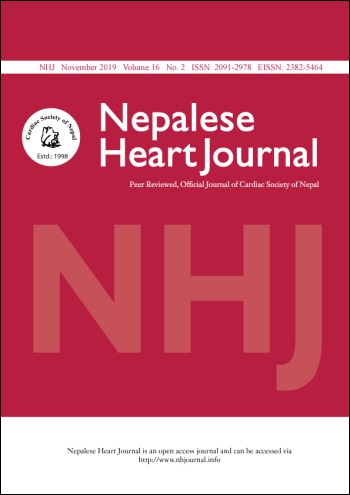Assessment of Rheumatic Mitral Stenosis severity by Mitral Leaflet Separation Index
DOI:
https://doi.org/10.3126/njh.v16i2.26316Keywords:
Mitral stenosis, Mitral leaflet separation index, Planimetry, Pressure half timeAbstract
Background and Aims: Determining the severity of mitral stenosis (MS) is important for both prognostic and therapeutic reasons. Measurement of Mitral valve area (MVA) by planimetry is gold standard and accurate but is highly operator dependent. Pressure Half Time (PHT) is affected by hemodynamic significance. In this Study we evaluated severity of mitral stenosis by mitral leaflet separation index (MLS index, MLSI). This new index could be useful surrogate measure of the MVA.
Methods: This is a hospital based, cross-sectional observational study carried out in Shahid Gangalal National Heart Centre (SGNHC), Kathmandu, Nepal. Study included 82 patients with Rheumatic MS who had undergone echocardiographic examination from July 2018 to December 2018. The maximal separation of the mitral valve leaflet tips was measured from inner edge to inner edge in end diastole in the parasternal long axis and apical 4-chamber views. These two parameters were averaged to yield the MLSI. The index was compared with mitral valve area determined by planimetry method and PHT.
Results: Of the 82 study subjects, majority were females 72 (85.4%). The mean age of study patients was 37.33±11.56 years. 30.5% had mild MS by planimetry, 31.7% had moderate MS and 37.8% had severe MS. There was a very strong correlation between MLS index and MVA by planimetry ( r = 0.89, p<0.001) and MVA by PHT (r=0.95, p<0.001). MLS index less than 0.73 cm can predict severe MS with 93.2% sensitivity and 89.3% specificity. On the other hand MLS index more than 1.035cm can predict mild MS with 70% sensitivity and 89.3% specificity. Strong correlation exists between MLS index and MV severity in presence atrial fibrillation (AF) (r=0.879) for planimetry and (r=0.835) for PHT and in presence of coexisting mitral regurgitation (MR) (r=0.89) for planimetry and (r=0.86) for PHT.
Conclusion: MLSI has a strong correlation with MVA by planimetry and PHT. So, it can be used as a reliable method to assess severity of mitral stenosis and is a simple and easily obtainable. It has good correlation even in presence of AF and MR.
Downloads
Downloads
Published
How to Cite
Issue
Section
License
This license enables reusers to distribute, remix, adapt, and build upon the material in any medium or format, so long as attribution is given to the creator. The license allows for commercial use.




